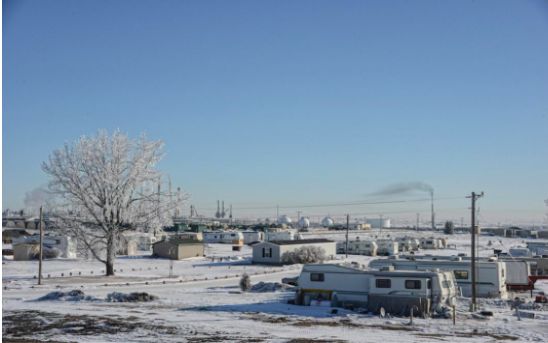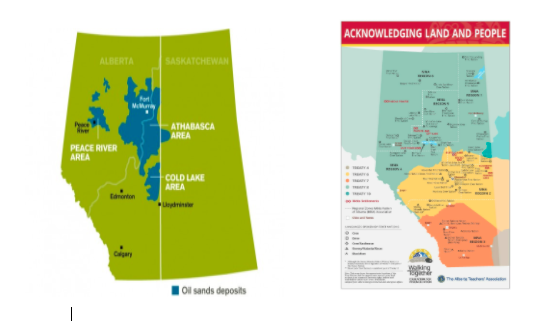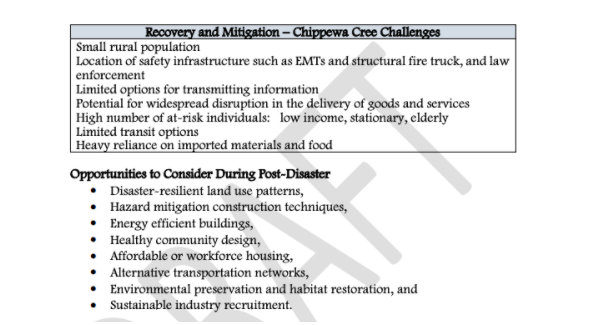Simultaneous Exploitation of Indigenous Women and Land
|
By: Willow Parchment, Samirah Aziz, Sari Gubar, and Priscilla Kendall According to Amnesty International (2016:49), the homicide rate for Indigenous women and girls in Canada is at least 6 times higher than the national average. These appalling statistics signal massive structural and societal problems stemming from colonization. Indigenous people and the land they are tied to, are subject to exploitation and violence by resource extraction companies. Powerful oil companies in conjunction with national governments are damaging the environment and perpetuate climate change while mistreating people. One Indigenous nation that has been subject to such abuses is the Cree Nation, which practices resistance through modes such as their climate action plan (Chippewa Cree 2018). Learning more about the Cree ongoing parallels between the exploitation of Tar Sands and the exploitation of Indigenous women is crucial to gaining a broad environmental mindset.  Man Camp in Tioga, North Dakota. Hess refinery in the background. Hess and its predecessor Amerada Petroleum have been involved with the Bakken Oil production since the beginning. Copyright Kyle Cassidy “Man camps” are temporary housing facilities, constructed for the workers of resource development projects in the oil, pipeline, mining, hydroelectric, and forestry industries, which are located on Indigenous territories. Accommodations can range from RVs and trailers to lodges to barracks–styleportables. While some are designed and advertised to be company-regulated, self-sufficient “communities,” with dining, laundry, and recreational facilities, other unregulated camps can be located on land rented out by local ranchers or farmers (Secwepemcul’ecw 2017). Separated from loved ones and social support, these men face stressful, difficult, and potentially dangerous working conditions, including long hours, shift work, and ‘two-week in, two-week out’ work schedules. These conditions have been reported to exacerbate isolation, mental illness, drug and alcohol abuse, violence, misogyny, and racism. Huffpost reports a 7.2 percent increase in overall crime in the vicinity of man camps, including 23,647 arrests of men for everything from forcible rape, drug abuse, prostitution, and “other” sexual offenses (Nienaber 2017). Adjacent to these issues, many Indigenous communities are afraid to take part in normal activities, like frequenting their local casinos, walking after dark, and being alone outside (Buckley 2014). There are also environmental concerns, camp litter, and land destruction. These camps are part of the continuing profit of resource extraction such as that of the Tar Sands. Resource extraction for profit is antithetical to Indigenous environmentalism (Gilio- Whitaker 2019).
Indigenous lands and bodies alike are being ravaged by Tar Sands extraction that destroys large amounts of boreal forest, and requires huge quantities of water, energy, and harmful chemicals. Extraction produces toxic wastewater, millions of liters of which are released into local rivers and streams. The Alberta Government allows energy companies to withdraw up to 11 billion gallons of water for the process (Indigenous Environmental Network 2018). Toxic waste eventually finds itself on Indigenous lands like the Cree, Dene, and Metis territories in Canada (Indigenous Environmental Network 2018), releasing carcinogenic and toxic pollutants that compromise the water quality for the people, aquatic life, and wildlife.  Maps of Alberta Canada show overlap between oil sands deposits and Indigenous territories, including the Cree, Dine, and Metis lands. Copyright Parkland Institute (2017) and Alberta School Councils’ Association (ASCA 2020), respectively. The transport of tar sands is equally dangerous, whether it’s by tanker, pipeline, or train. Between 2010 and 2017, four pipeline companies spilled 63,000 barrels of hazardous liquids, including crude oils (Donaghy and Carter, 2017). A study done in 2009 showed that polycyclic aromatic hydrocarbons (PAHs) were found up to 30 miles away from oil refining facilities. PAHs are known to damage DNA and cause cancer, developmental impacts, nausea, skin rashes, memory loss, and much more (NRDC, 2014). Even with all of the adverse effects, the environmental impacts are just the half of it. Horrifyingly enough, there is also ample evidence that tar sands extraction sites and the “man-camps” that are built on them are linked to the kidnapping and abuse of Indigenous women and girls (Clabots, 2019). Man camps cause additional hardship for Indigenous women and girls in the form of economic devastation. High wages for resource extraction workers drives up prices in the area, and Indigenous women cannot afford the cost of living. One major reason for this is the immense pay gap between indignous women and white men; Indigenous women are paid 58 cents to the white man’s dollar (Amnesty International 2016:51). The economic insecurity created by the presence of man camps leads women to enter relationships in order to meet housing and food needs (2016:49). Indigenous women and girls do not have access to adequate government support, with women’s shelters and food banks in the area critically underresouced (2016:59). Demands for commercial sex rises in resource extraction areas becasuse lots of men are brought in and they have money to spend. This economic power emboldens temporary workers to express racist and sexist values, fetishizing and hypersexualizing Indigenous women and girls. While most non-Indigneous women and girls interviewed by Amnesty International (2016) said they felt relatively safe on St. John (a northern Canadian city) streets, Indigenous women consistently reported feeling unsafe both at night and during the day due to racial slurs, catcalling, following in cars and more (2016:52). Not only are Indigenous women victims of higher rates of violence, they are also more likely to be killed. Indigenous women are also scared to report violence because of fear of mistreatment or punishment by law enforcement officials (2016:49).  A segment of one of the Cree Tribal Emergency Committee’s vulnerability assessments, which provide clarifications about environmental risks and tribal challenges. Copyright Chippewa Cree Climate Adaptation Plan (2018). Indigenous environmentalism also views gender violence as an environmental threat (Gilio-Whitaker 2019). For instance, the writers of the Cree Climate Action Plan prioritize the safety of the environment as well as Indigenous women. A key component of the plan is respect for all of creation (Chippewa Cree 2018; 8). Overcoming the negative impacts of climate change requires the participation of all people including Indigenous women. However, the federal government tends to place financial limitations on the types of cultural and climate resilience projects based on what it deems relevant (Chippewa Cree 2018; 32). In spite of this, the Cree tribe has formed a Tribal Emergency Response Committee along with detailed vulnerability assessments, part of which is included in the figure below (Chippewa Cree 2018; 43,59). This acknowledges that the safety of Cree women is a priority due to the interconnections between the Cree and the environment. As the writers eloquently state, “We [the Cree tribe] are determined to foster peaceful, just and inclusive societies which are free from fear and violence. There can be no sustainable development without peace and no peace without sustainable development” (Chippewa Cree 2018; 67). Government sanctions, tar sands extraction, and the “man-camps” that come with it endanger both Indigenous lands and people, polluting water, clearing forests, abusing women, and disrupting Aboriginal Nations’ ways of life. In the face of environmental, governmental, and physical violence, Indigenous people have persevered and are fighting back. Respecting Aboriginal Values and Environmental Needs (RAVEN) is an organization working to raise legal funds to defend Indigenous Nations from the Canadian government’s forceful industrialization of Indigenous lands. Additionally, the Tar Sand Trial campaign is raising money to support another Cree Nation, the Beaver Lake Nation, which is suing the federal government for failing to uphold Cree land rights due to tar sands expansion. Both RAVEN and Tar Sands Trial are currently taking donations and have many opportunities to get involved with their campaigns on their websites. Checking out the websites and donating to Indigenous activist groups like RAVEN, Seeding Sovereignty, and the National Indigenous Women’s Center are direct ways to support Indidenous women, as well as great ways to educate yourself and others on Indigenous rights, issues, and campaigns.
References Cited Amnesty International 2016. Out of Sight, Out of Mind: Indigenous Rights, and Energy Development, in Northeast British Columbia, Canada. Electronic Document; https://www.amnesty.ca/sites/amnesty/files/Out%20of%20Sight%20Out%20of%20Mind%20EN%20FINAL%20web.pdf Buckley,Damon 2014. Firsthand Account Of Man Camp In North Dakota From Local Tribal Cop. Lakota Times. Web page; https://www.lakotatimes.com/articles/firsthand-account-of-man-camp-in-north-dakota-from-local-tribal-cop/ Chippewa Cree 2018. Chippewa Cree Climate Action Plan. Electronic Document; https://mainstreetmontanaproject.com/wpcontent/uploads/2019/11/Climate-Action-Plan.pdf Clabots, Barbara 2019. The Darkest Side of Fossil-Fuel Extraction. Scientific American. Web Page; https://blogs.scientificamerican.com/voices/the-darkest-side-of-fossil-fuel-extraction/ Donaghy, Tom and Lawrence Carter 2017. Tar sands pipeline companies oversee hundreds of oil spills. Unearthed. Web page; https://unearthed.greenpeace.org/2017/08/10/tar-sands-pipeline-oil-spills/ Gilio-Whitaker, Dina 2019. As Long as Grass Grows: The Indigenous Fight for Environmental Justice, From Colonization to Standing Rock. Beacon Press, Boston. Honor The Earth N.d. Man Camps Fact Sheet: Chasing out the Specter of Man Camps. Web Page; http://www.honorearth.org/man_camps_fact_sheet Indigenous Environmental Network 2018. Tar Sands. Indigenous Environmental Network. Web Page; https://www.ienearth.org/what-we-do/tar-sands/ Nienaber, Georgianne 2017. Man Camps and Predator Economics Threaten Heartland Native Communities. Huffpost. Web Page; https://www.huffpost.com/entry/man-camps-and-predator-ec_b_3700640 NRDC 2014. Tar Sands Crude Oil: Health Effects of a Dirty and Destructive Fuel. NRDC. 14-02-B. Electronic Document; https://www.nrdc.org/sites/default/files/tar-sands-health-effects-IB.pdf Secwepemcul’ecw 2017. What are Man Camps. Secwepemculecw. Web page; https://www.secwepemculecw.org/no-mans-camps. Images Cited: ASCA 2020. First Peoples Map of Alberta. Alberta School Councils’ Association. Webpage; https://www.albertaschoolcouncils.ca/about/indigenous-awareness/first-peoples-in-alberta Chippewa Cree 2018. Chippewa Cree Climate Action Plan. Electronic Document; https://mainstreetmontanaproject.com/wpcontent/uploads/2019/11/Climate-Action-Plan.pdf Parkland Institute 2017. Ten things to know about Indigenous people and resource extraction in Alberta. Parkland Blog. Web page; https://www.parklandinstitute.ca/ten_things_to_know_about_indigenous_people_and_resource_extraction_in_alberta Teicher, Jordan G. 2016. Inside the Temporary Homes of North Dakota Oil Workers. Slate. Web page; https://slate.com/culture/2016/03/kyle-cassidy-photographs-the-homes-of-oil-workers-in-north-dakota-in-the-bakken-goes-boom.html Further Action Sites: https://raventrust.com/donate/ https://fundraise.raventrust.com/give/152448/#!/donation/checkout http://www.honorearth.org/action https://seedingsovereignty.org/ https://www.facebook.com/mmiwusa/
|
This is an important topic that I’m glad you’ve written about. These connections make it all the more important to recognize intersectional environmentalism.
It would be nice to have your full names listed at the top after “By” instead of “BY”, but besides that I like this piece!